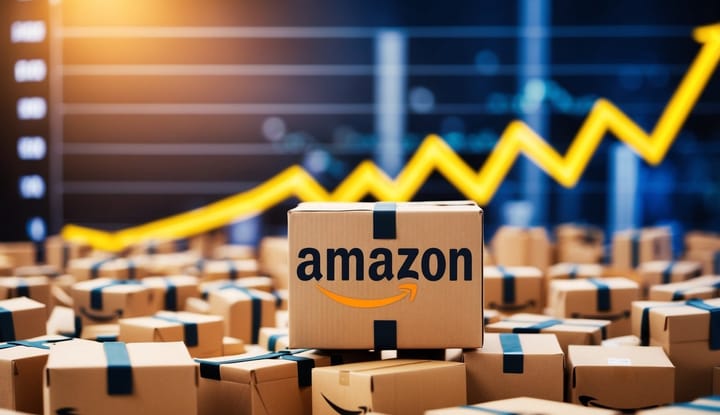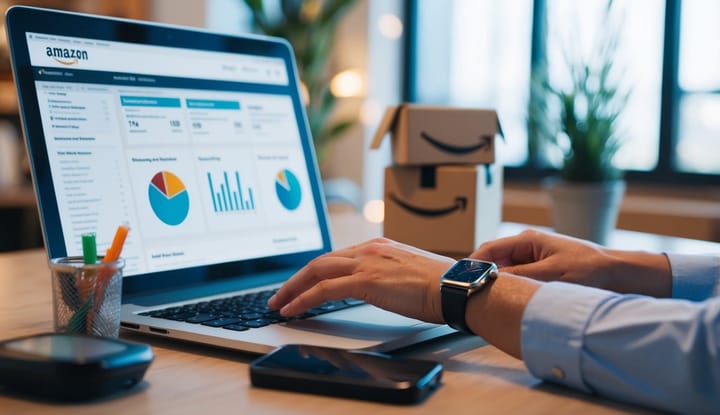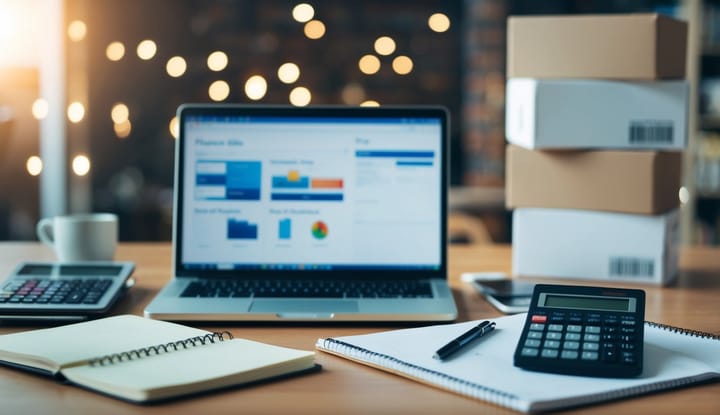Amazon Seller Stats: Key Insights for FBA Success

Are you ready to unlock the secrets of Amazon's e-commerce empire? Let's explore the 2024 Amazon FBA statistics together. This journey will open doors for sellers in Singapore and worldwide. The Amazon marketplace is a giant in online retail, offering huge chances for success.
In 2023, Amazon took a huge 37.6% of the U.S. e-commerce market, with revenues hitting $575 billion. This shows the strength of Amazon sellers. More than 60% of Amazon's sales come from outside Amazon itself, proving the importance of independent sellers.
Thinking about selling on Amazon? The numbers look good. About 58% of sellers make money in their first year. In fact, U.S. sellers made over $250,000 a year in 2023, showing Amazon's big earning potential.
Key Takeaways
- Amazon holds 37.6% of the U.S. e-commerce market share
- Third-party sellers contribute over 60% of all Amazon sales
- 58% of Amazon sellers become profitable within a year
- U.S.-based sellers average $250,000+ in annual sales
- Brand owners' sales grew by 22% in the Amazon store in 2023
- FBA shipping costs 70% less than comparable premium options
- Basic A+ Content can boost sales by up to 8%
Amazon's Dominance in the E-commerce Landscape
Amazon has a strong hold on the e-commerce market. It has changed how people shop online and set new standards. Let's look at the numbers that show how big Amazon is and its effect on businesses and shoppers.
Market Share and Revenue Growth
In the U.S., Amazon leads with a 37.8% market share in e-commerce. This means it makes a lot of money. In 2023, it earned $554.02 billion, up from $513.98 billion the year before. This growth comes from many areas like online stores, and third-party sellers.
Consumer Behavior and Search Preferences
Amazon is where people go to shop online. It has over 310 million users worldwide, with over 200 million Prime members. Prime members spend about $1,400 a year, more than non-Prime users spend at $600.
Impact on Small and Medium-sized Businesses
Small businesses find both chances and challenges on Amazon. Over 2 million sellers are active, with 3,700 new ones joining every day. About 60% of sales come from third-party sellers, showing how Amazon helps small businesses grow.
| Metric | Value |
|---|---|
| U.S. E-commerce Market Share | 37.8% |
| Annual Revenue (2023) | $554.02 billion |
| Active Users Globally | 310 million+ |
| Prime Members | 200 million+ |
| Active Sellers | 2 million+ |
These numbers show how big Amazon is in the market, its growth, and how it affects shoppers. For small businesses, knowing these facts is key to doing well in the competitive online shopping world.
Third-Party Sellers: The Backbone of Amazon's Success
Amazon's marketplace is powered by independent sellers. In 2024, over 2.5 million third-party sellers are active, making a big part of Amazon's sales. These sellers, often small and medium-sized businesses, use seller central to run their shops and reach lots of customers.
Third-party sellers on Amazon do really well. In their first year, 64% of them make money. This shows new businesses can do great on Amazon. About 46% of sellers do pretty well, selling between 11% and 25% of what they make.
Fulfillment by Amazon (FBA) is key to their success. A huge 86% of sellers pick FBA to handle their orders. This lets sellers use Amazon's strong delivery network. It helps them work better and serve customers better.
But, the platform has its challenges. In 2020, many FBA sellers worried about more competition and lower prices. To compete, sellers need to focus on quality, service, and smart pricing. By using seller central tools and keeping up with trends, third-party sellers keep leading Amazon's success.
Amazon FBA Statistics 2024: Trends and Opportunities
Amazon FBA is a big deal in e-commerce for 2024. It has 310 million active customers worldwide. This makes it a great place for sellers to find opportunities.
Popular Product Categories for FBA Sellers
Fashion & Apparel is a top choice for sellers, with a growth rate of 12.4% from 2022 to 2027. Health & Beauty is close behind at 12.1%, and Products and Electricals are growing at 11.6%. These areas are great for FBA sellers to get into.

Profitability and Sales Performance
Amazon sellers are doing well. 58% of them make money in their first year. 52% sell over $1,000 a month, and 19% of small businesses make more than $10,000 a month. These numbers show the chance for success on Amazon.
Fulfillment Methods and Strategies
Most sellers, 82%, choose Amazon FBA for shipping. FBA is cheaper, saving sellers about 70% per item compared to big U.S. carriers. This lets sellers work on making products and marketing, like using Amazon Ads.
Creating your own products and brands is popular, with 54% of sellers doing it. This gives them control over prices and branding. Most sellers price their items between $16 and $50. These strategies are key to Amazon FBA success in 2024.
The Power of Amazon Prime and Its Impact on Sellers
Amazon Prime has changed the way we shop online. It has set high standards for what customers expect. With over 200 million Prime members worldwide, it's a big deal for both buyers and sellers on Amazon.
In the U.S., a huge 71% of people have an Amazon Prime account. This means millions of potential customers for sellers. This big user base is perfect for businesses to grow, especially during Prime Day.
Prime Day is Amazon's big shopping event. In 2023, Prime members bought over 375 million items during it. July 11 was the biggest sales day ever for Amazon. The 2024 Prime Day broke all records, showing how big this event has become.
Free shipping is key to the Prime experience. Now, 80% of U.S. consumers want free shipping on orders above a certain amount. This change has made sellers rethink their prices and how they ship items.
| Prime Membership Impact | Statistics |
|---|---|
| Global Prime Members | 200+ million |
| U.S. Population with Prime | 71% |
| Prime Members Spending $100+/month | 58% |
| Prime Day 2023 Items Sold | 375+ million |
For sellers, being part of Prime can really change things. 58% of Prime members spend over $100 a month on Amazon. This is a big chance for businesses to increase sales and get more visibility with Prime-eligible products.
Emerging Trends: AI, Omnichannel Marketing, and Global Expansion
The world of online shopping is changing fast. AI tools, omnichannel marketing, and selling globally are leading the way. Amazon sellers are quickly adapting to these new trends to keep up.
Adoption of AI Tools Among Amazon Sellers
AI is changing how we do business online. The market for AI in e-commerce is expected to hit $25.1 billion by 2032, growing at a 15.1% annual rate. About half of Amazon sellers now use AI tools to run their shops, with big brands leading at 69%.
Multi-platform Selling Strategies
Being able to sell across different channels is key to success. Most shoppers use several channels, making omnichannel shopping 27% of all retail sales. Amazon sellers are reaching more customers by selling on platforms like eBay, Shopify, and Walmart. Instagram and WordPress are also becoming popular for Amazon sellers.
International Marketplace Growth
More Amazon sellers are going global. 46% of U.S. Amazon sellers sell in other countries. India has seen a 33% increase in sellers, while France has seen an 8% rise. This shows how important it is for sellers to sell on multiple platforms and in different countries.
| Trend | Statistic |
|---|---|
| AI Adoption | 48% of Amazon sellers |
| Omnichannel Shopping | 27% of retail sales |
| International Expansion | 46% of U.S. Amazon businesses |
Conclusion: Navigating the Future of Amazon Selling
The future of Amazon selling is set to be shaped by e-commerce trends. Sellers need to adapt and innovate to succeed. In 2024, AI will be key, giving sellers insights into what customers want.
This tech leap will change how sellers list products and serve customers. The Singapore market is a great chance for growth. It's tech-savvy and has strong infrastructure, making it a key e-commerce spot.
Sellers who use this market and global trends well will get ahead. Amazon's recent FBA fee updates highlight the importance of staying informed. To succeed, sellers should focus on quality content, video marketing, and quick commerce.
The future of Amazon looks bright for those who can handle these changes well. By keeping up with trends, using new tech, and focusing on customers, sellers can do well. As we move into 2024 and beyond, success comes from learning, adapting, and exploring new Amazon selling opportunities.
Frequently Asked Questions
Q: What are the latest Amazon seller statistics for 2024?
A: As of 2024, there are over 9.7 million Amazon sellers worldwide, with more than 1.9 million active sellers. Amazon's net sales reached $514 billion in 2023, showing a 9% increase from the previous year. Additionally, third-party sellers account for approximately 60% of all sales on the Amazon marketplace.
Q: How many Amazon sellers use Amazon FBA?
A: Approximately 92% of top Amazon sellers use Amazon FBA (Fulfillment by Amazon) to handle their shipping and logistics. This service has become increasingly popular among sellers due to its efficiency and the ability to offer Prime shipping to customers.
Q: What percentage of Amazon sellers are profitable?
A: According to recent surveys, about 64% of Amazon sellers report being profitable within their first year of selling on the platform. However, profitability can vary greatly depending on factors such as product niche, competition, and marketing strategies.
Q: How much do top Amazon sellers make in sales revenue?
A: Top Amazon sellers can generate significant sales revenue. On average, 50% of Amazon sellers make between $1,000 to $25,000 per month in sales. However, the top 1% of Amazon sellers report monthly sales exceeding $1 million, showcasing the platform's potential for high-volume sales.
Q: What impact does Amazon Prime Day have on seller statistics?
A: Amazon Prime Day has a substantial impact on seller statistics. During Prime Day 2023, third-party sellers generated over $3.5 billion in sales, representing a 60% increase compared to the previous year. This event provides a significant opportunity for sellers to boost their sales and visibility.
Q: How many products does the average Amazon seller list on the platform?
A: The average Amazon seller lists about 20 products on the platform. However, this number can vary widely depending on the seller's business model and niche. Some successful sellers focus on a small number of high-quality products, while others maintain larger inventories.
Q: What percentage of Amazon sellers use Amazon Advertising?
A: Approximately 74% of Amazon sellers use Amazon Advertising to promote their products. This high adoption rate is due to the effectiveness of Amazon's advertising platform in increasing product visibility and driving sales within the marketplace.
Q: How has the number of Amazon sellers changed in recent years?
A: The number of Amazon sellers has been steadily increasing. In 2023, there was a 6% year-over-year growth in the number of active sellers on the platform. This trend is expected to continue as more entrepreneurs and businesses recognize the potential of selling on Amazon.
Q: What percentage of Amazon customers shop exclusively on Amazon?
A: According to recent Amazon statistics, approximately 89% of Amazon customers say they are more likely to buy products from Amazon than other e-commerce sites. This loyalty is largely attributed to factors such as competitive pricing, wide product selection, and the convenience of Amazon Prime membership.
Q: How much do Amazon sellers spend on advertising?
A: On average, Amazon sellers spend about 10-15% of their total sales revenue on advertising. However, this can vary depending on the product category and competition level. Some sellers in highly competitive niches may spend up to 30% of their revenue on advertising to maintain visibility and drive sales.
Want to uncover key insights for Amazon FBA success? Join our FREE WAH Academy Training Group to learn data-driven strategies and actionable tips to thrive as a seller!
No cost, just valuable advice—click below to get started!



